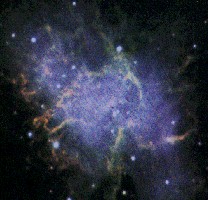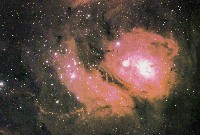
This nebula is a super nova remnant nebula. This nebula is approximatly 6000 light years from Earth. It is located in the constellation Tarus. It was discovered in 1758 Charles Messier. He found it when he was looking for comets. When he looked at this nebula he noticed that it didn't move like a ordinary coment. So he decided to create a catalog of things that shouldn't be mistaken for coments (from his point of view). The supernova that created this nebula was seen on approximatly July 4, 1054 AD by Chinease astronomers. It was so bright it could be seen during the daytime. The event itself happened in about 5,400 BC. The reason for this is because it takes a while for the light which produced it to get to earth. What we are seeing today is what the nebula looked like 6,000 years ago because that is the amount of time for the light to get here. The gas of this nebula is expanding so fast that we can see the difference in the size of it when comparing it to photographs taken earlier in the century. At the center of this nebula is a pulsar. A pulsar is mainly what remains from a super nova. It is only a few kilometers in diameter but is so dense it has the equivilant mass of our sun. Pulsars also rotate very rapidly, the one in the Crab nebula rotates once every 33 milliseconds. The location of this nebula is:
The crab nebula is only a few light years accross. it has a catalog number of NGC 1952.

The Lagoon Nebula is a cluster nebula. A Cluster Nebula is a nebula whre stars formed in it from its material, which lit up the nebula so that we can see it here on earth. The nebulas actual type is an emmision nebula. It is located in the constellation Sagittarius and is about 5,000 light years from Earth. If you want to find it in the night sky it is located at:
It was discovered by Flamsteed in about 1680. Le Gentil also found the nebula in 1747. The nebula was cataloged by Charles Messier on May 23, 1764. This nebula gets its name from a dark band of dust separating it into two bright sections. This nebula is much brighter than its neighbor, the Trifid Nebula. The Lagoon Nebula is known as NGC 6530, and as is stated earlier it contains many new stars that formed from this nebula. Also in the Lagoon Nebula is the presence of a dark nebula called globules. This are collasping protostellar clouds with diameters of about 10,000 AU. AU stands for Astronomical Units.